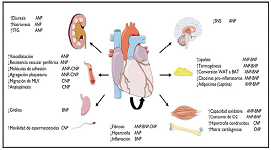
Asia Pacific Academy of Science Pte. Ltd. (APACSCI) specializes in international journal publishing. APACSCI adopts the open access publishing model and provides an important communication bridge for academic groups whose interest fields include engineering, technology, medicine, computer, mathematics, agriculture and forestry, and environment.

Effect of short-term high-dose atorvastatin on apoE-/-mouse atherosclerosis model
Vol 3, Issue 1, 2022
Download PDF
Abstract
Objective: To explore the intervention mechanism of short-term high-dose atorvastatin on atherosclerotic (as) plaque. Methods: 4-week-old male apoE-/- mouse were fed with high fat for 6 weeks to establish as model. They were randomly divided into control group, model group, atorvastatin conventional dose group, medium dose group and high dose group (load dose group and non load dose group). After 2 weeks, the blood lipid level, inflammatory factor concentration, platelet number, platelet membrane protein expression level and plaque area of each group were compared. Results: Compared with the model group, HDL-C increased significantly, LDL-C decreased significantly, the levels of inflammatory factors in serum and plaque decreased significantly, PLT decreased significantly, and the fluorescence intensity of CD31 and CD62p decreased significantly (all P < 0.05); The level of ox LDL in the load dose group was significantly lower than that in the model group (P < 0.05). The plaque area of atorvastatin intervention groups was significantly lower than that of model group (all P < 0.05). Conclusion: Short-term high-dose atorvastatin may intervene as by reducing blood lipid level, inhibiting the release of related inflammatory factors and regulating the number of platelets and the expression of platelet membrane protein.
Keywords
References
- Bondonno CP, Blekkenhorst LC, Prince RL, et al. Association of Vegetable Nitrate Intake with Carotid Atherosclerosis and Ischemic Cerebrovascular Disease in Older Women. Stroke. 2017; 48(7): 1724-1729. doi: 10.1161/strokeaha.117.016844
- Ndrepepa G, Colleran R, Kastrati A. Gamma-glutamyl transferase and the risk of atherosclerosis and coronary heart disease. Clinica Chimica Acta. 2018; 476: 130-138. doi: 10.1016/j.cca.2017.11.026
- LaRosa JC, Grundy SM, Waters DD, et al. Intensive Lipid Lowering with Atorvastatin in Patients with Stable Coronary Disease. New England Journal of Medicine. 2005; 352(14): 1425-1435. doi: 10.1056/nejmoa050461
- Mancini G, Martins WC, de Oliveira J, et al. Atorvastatin Improves Mitochondrial Function and Prevents Oxidative Stress in Hippocampus Following Amyloid-β1–40 Intracerebroventricular Administration in Mice. Molecular Neurobiology. 2020; 57(10): 4187-4201. doi: 10.1007/s12035-020-02026-w
- Yang X, Xiong T, Ning D, et al. Long-term atorvastatin or the combination of atorvastatin and nicotinamide ameliorate insulin resistance and left ventricular diastolic dysfunction in a murine model of obesity. Toxicology and Applied Pharmacology. 2020; 402: 115132. doi: 10.1016/j.taap.2020.115132
- Guo H, Xu F, Lv H, et al. Hyperhomocysteine-mia independently causes and promotes atherosclerosis inLDL receptor-deficient mice. J Geriatr Cardiol. 2014; 11(1): 74-78.
- Ding H. Experimental Pharmacology. Beijing: Science Press; 2008. pp. 13-16.
- Li X, Xiao H, Lin C, et al. Synergistic effects of liposomes encapsulating atorvastatin calcium and curcumin and targeting dysfunctional endothelial cells in reducing atherosclerosis. International Journal of Nanomedicine. 2019; 14: 649-665. doi: 10.2147/ijn.s189819
- Coutinho JM, Middeldorp S, Stam J. Advances in the Treatment of Cerebral Venous Thrombosis. Current Treatment Options in Neurology. 2014; 16(7). doi: 10.1007/s11940-014-0299-0
- Sun B, Rui R, Pan H, et al. Effect of Combined Use of Astragaloside IV (AsIV) and Atorvastatin (AV) on Expression of PPAR-γ and Inflammation-Associated Cytokines in Atherosclerosis Rats. Medical Science Monitor. 2018; 24: 6229-6236. doi: 10.12659/msm.908480
- Cao B, Bi G, Wang Y. Pharmacology of atorvastatin on myocardial ischemia-reperfusion in rats and drug effect analysis. Pak J Pharm Sci. 2019; 32(5(special)): 2443-2447.
- Zhu Z, Li J, Zhang X. Astragaloside IV Protects Against Oxidized Low-Density Lipoprotein (ox-LDL)-Induced Endothelial Cell Injury by Reducing Oxidative Stress and Inflammation. Medical Science Monitor. 2019; 25: 2132-2140. doi: 10.12659/msm.912894
- Cai L, Zhang X, Hou M, et al. Natural flavone tricetin suppresses oxidized LDL-induced endothelial inflammation mediated by Egr-1. International Immunopharmacology. 2020; 80: 106224. doi: 10.1016/j.intimp.2020.106224
- Wolf D, Ley K. Immunity and Inflammation in Atherosclerosis. Circulation Research. 2019; 124(2): 315-327. doi: 10.1161/circresaha.118.313591
- Abela OG, Ahsan CH, Alreefi F, et al. Plaque Rupture and Thrombosis: the Value of the Atherosclerotic Rabbit Model in Defining the Mechanism. Current Atherosclerosis Reports. 2016; 18(6). doi: 10.1007/s11883-016-0587-0
- Wang X, Cai X, Chen L, et al. The Evaluation of Plasma and Leukocytic IL-37 Expression in Early Inflammation in Patients with Acute ST-Segment Elevation Myocardial Infarction after PCI. Mediators of Inflammation. 2015; 2015: 1-6. doi: 10.1155/2015/626934
- Shadab M, Millar MW, Slavin SA, et al. Autophagy protein ATG7 is a critical regulator of endothelial cell inflammation and permeability. Scientific Reports. 2020; 10(1). doi: 10.1038/s41598-020-70126-7
- Badimon L, Vilahur G. Thrombosis formation on atherosclerotic lesions and plaque rupture. Journal of Internal Medicine. 2014; 276(6): 618-632. doi: 10.1111/joim.12296
- Tan C, Liu D, Yin J. Effects of clopidogrel combined with atorvastatin on platelets, hemorheology, D-Dimer and hs-CRP in patients with acute myocardial infarction. Journal of Zunyi Medical College. 2017; 40(1): 68-71.
- Deng Y, Zou W, Chen G, et al. Comparative studies on the effects of different doses of atorvastatin combined with aspirin on inflammatory cytokines and carotid plaques in patients with ischemic cerebrovascular disease. International Journal of Neuroscience. 2019; 129(11): 1133-1138. doi: 10.1080/00207454.2019.1635592
- Bot I, Jukema JW, Lankhuizen IM, et al. Atorvastatin inhibits plaque development and adventitial neovascularization in ApoE deficient mice independent of plasma cholesterol levels. Atherosclerosis. 2011; 214(2): 295-300. doi: 10.1016/j.atherosclerosis.2010.11.008
Supporting Agencies
Copyright (c) 2022 Wei Yang, Chao He, Zaiqiang Zhang, Hui Wu, Lin Teng, Jiawang Ding

This work is licensed under a Creative Commons Attribution 4.0 International License.

This site is licensed under a Creative Commons Attribution 4.0 International License (CC BY 4.0).

Prof. Prakash Deedwania
University of California,
San Francisco, United States




